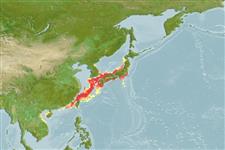Common names from other countries
Classification / Names
Nombres comunes | Sinónimos | Catalog of Fishes(Género, Especie) | ITIS | CoL | WoRMS | Cloffa
>
Gobiiformes (Gobies) >
Gobiidae (Gobies) > Gobiinae
Etymology: Obliquogobius: Latin, obliquus = having slating direction or position + Latin, gobius = gudgeon (Ref. 45335); yamadai: Named for Umeyoshi Yamada, for his great contribution to our knowledge of fishes in the East China Sea..
Environment: milieu / climate zone / depth range / distribution range
Ecología
marino demersal; rango de profundidad 99 - 165 m (Ref. 75138). Temperate
Northwest Pacific: East China Sea and Japan.
Tamaño / Peso / Age
Maturity: Lm ? range ? - ? cm
Max length : 5.2 cm SL macho / no sexado; (Ref. 75138); 5.3 cm SL (female)
Short description
Morfología | Morfometría
Espinas dorsales (total): 7; Radios blandos dorsales (total): 9; Espinas anales 1; Radios blandos anales: 9; Vértebra: 26. This species is distinct from its congeners in having the following characters: second dorsal-fin rays I, 9-10 (almost always I, 9); anal-fin rays I, 9-10 (almost always I, 9); scaled cheek and pectoral-fin base; asymmetrical caudal fin, with fifth or sixth segmented ray slightly elongate and longest; head length (HL), 28.8-33.5% of SL; eye diameter 32.7-37.3% HL, 9.6-12.3% of SL; grayish body with about 7 narrow, transverse yellow bars (pale in preservation); absence of distinct black-and-white barred pattern on caudal fin (Ref. 75138).
It has been suggested that some specimens were possibly captured from sandy or sandy-mud bottoms in the center and/or western parts of Tosa Bay at the depths of 30-100 m (Ref. 75138).
Life cycle and mating behavior
Madurez | Reproducción | Puesta | Huevos | Fecundidad | Larva
Shibukawa, K. and Y. Aonuma, 2007. Three new species of the deep-dwelling goby genus Obliquogobius (Perciformes: Gobiidae: Gobinnae) from Japan, with comments on the limits of the genus. Bull. Natl. Mus. Nat. Sci., Ser. A, Suppl. 1:137-152. (Ref. 75138)
IUCN Red List Status (Ref. 130435)
CITES (Ref. 128078)
Not Evaluated
Threat to humans
Harmless
Human uses
Más información
Nombres comunesSinónimosMetabolismoDespredadoresEcotoxicologíaReproducciónMadurezPuestaFecundidadHuevosEgg development
Age/SizeCrecimientoLength-weightLength-lengthLength-frequenciesMorfometríaMorfologíaLarvaDinámica larvariaReclutamientoAbundancia
ReferenciasAcuiculturaPerfil de acuiculturaRazasGenéticaElectrophoresesheritabilidadEnfermedadesProcesamientoMass conversion
ColaboradoresImágenesStamps, Coins Misc.SonidosCiguateraVelocidadTipo de nataciónSuperficie branquialOtolitosCerebrosVisión
Herramientas
Special reports
Download XML
Fuentes de Internet
Estimates based on models
Phylogenetic diversity index (Ref.
82804): PD
50 = 0.5156 [Uniqueness, from 0.5 = low to 2.0 = high].
Bayesian length-weight: a=0.00912 (0.00295 - 0.02818), b=2.98 (2.72 - 3.24), in cm Total Length, based on LWR estimates for this (Sub)family-body shape (Ref.
93245).
Nivel trófico (Ref.
69278): 3.2 ±0.3 se; based on size and trophs of closest relatives
Resiliencia (Ref.
120179): Alto, población duplicada en un tiempo mínimo inferior a 15 meses (Preliminary K or Fecundity.).
Fishing Vulnerability (Ref.
59153): Low vulnerability (10 of 100).
